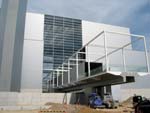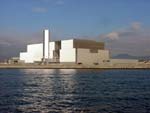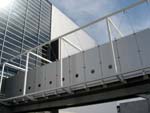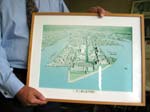
|
|
|
|
 |
|
Home Site Search Contact Us Subscribe
|
|
|
|
Beauty in Garbage: Naka Incineration Plant by Yoshio Taniguchi
Hiroshima: An incineration plant is devised as real-time science museum and tourist destination (complete with waterfront park). by Fred A. Bernstein November 9, 2004 Japanese architect Yoshio Taniguchi
has two new buildings to his credit. One is the Museum of Modern Art, opening
later this month in New York City. The other is an incinerator in Hiroshima,
which Taniguchi proudly refers to as "my museum of garbage.” The two buildings are comparable
in scale and cost. Both were designed to dazzle architecture buffs, with
Taniguchi's extraordinarily refined details, and to attract tourists. In commissioning the $400 million
Naka Incineration Plant, Hiroshima's long-time mayor, Takashi Hiraoka, was
trying to address two problems. First, the city – rebuilt in a hurry after
World War II – was a warren of bleak architecture. (The various monuments to
the atomic bomb blast, by Kenzo Tange, Isamu Noguchi, and others, are
exceptions.) In 1995, on the 50th anniversary of the blast, Mayor Hiraoka
announced a design initiative; it has already produced a dazzling, all-glass
fire station. Second, the city of 1.1 million is
facing a garbage explosion. The mayor figured that if people could see how much garbage they produce, they might begin to produce less. So why not open the new processing plant to the public – a kind of real-time science museum? And why not hire Japan's preeminent museum architect, Yoshio Taniguchi, to design it? Taniguchi conceives buildings as
urban planning interventions. At MoMA, with its famous sculpture garden, his
conceit is that the museum is a microcosm of Manhattan: a group of buildings
surrounding a park. In Hiroshima, the incinerator, though massive (490,000
square feet), is, improbably, a pathway to the water. Its site, at the end of one of
Hiroshima's main boulevards, overlooks the city's harbor. But the building
would have entirely blocked residents’ access to the water. So Taniguchi
decided to continue the boulevard, in the form of a raised, glass-enclosed
walkway. Beginning where the pavement ends, the 400-foot walkway slips through
the building, ending in a new waterfront park. On either side of the walkway are
vast, stainless steel machines, like five-story-high Cuisinarts. But that’s only the beginning.
Follow a well-marked visitor's route (graphics are by San Francisco's Tamotsu
Yagi, best known for Benetton and Esprit campaigns) down long hallways, with
windows overlooking a trash pit so deep that discarded futons near the bottom
look like pieces of confetti. Two men sit in a glass-floored
control room cantilevered over the pit. Using joysticks, they operate giant
hooks that transfer house-sized clumps of garbage into hoppers. From there,
Hiroshima’s refuse makes its way through a maze of extractors and processors.
What's left emerges from the building through a 180-foot, rectilinear chimney.
(Environmentalists have raised questions about the release of dioxins into the
atmosphere, though city officials claim there is no problem.) The plant
produces 15,200 kilowatts of electricity when operating fully. The entire building (except the
pit itself) is eat-off-the-floor clean. And Taniguchi’s architecture,
white-on-white-on-silver, gently asymmetrical but always carefully
proportioned, ennobles the entire operation. (Workers leave their shoes at the
front door.) It is too early to say if it the
dazzling incinerator will reduce trash production, but, by calling attention to
the problem, it can only help. Other cities – including Editor’s note: Photos of the Naka Incineration Plant appear in the
November 2004 issue of Metropolis
(along with a profile of Yoshio Taniguchi by Bernstein). Fred Bernstein studied architecture at Also by Bernstein: Second
Look: George Washington Bridge Bus Station / Pier Luigi Nervi, 1963 INSIGHT:
The Might-Have-Been Memorial Of
the 5,200 or so entries in the memorial competition, mine was one of the ones
that the judges liked. But… |
(click on pictures to enlarge)  (Fred A. Bernstein) Naka Incineration Plant, Hiroshima, under construction (City of Hiroshima) View from the water (Fred A. Bernstein) Walkway detail (Fred A. Bernstein) Official holding site plan |
© 2004 ArchNewsNow.com